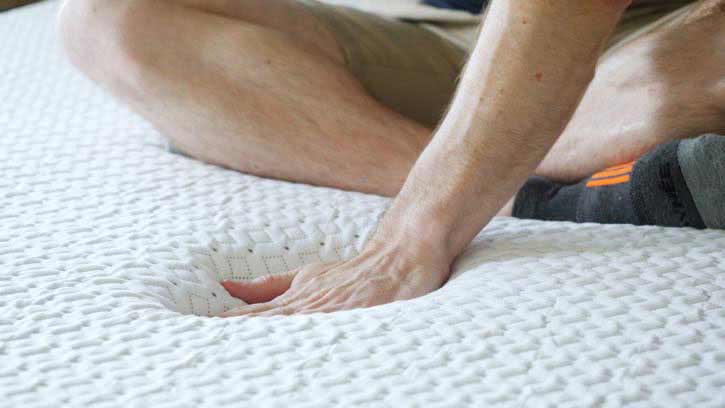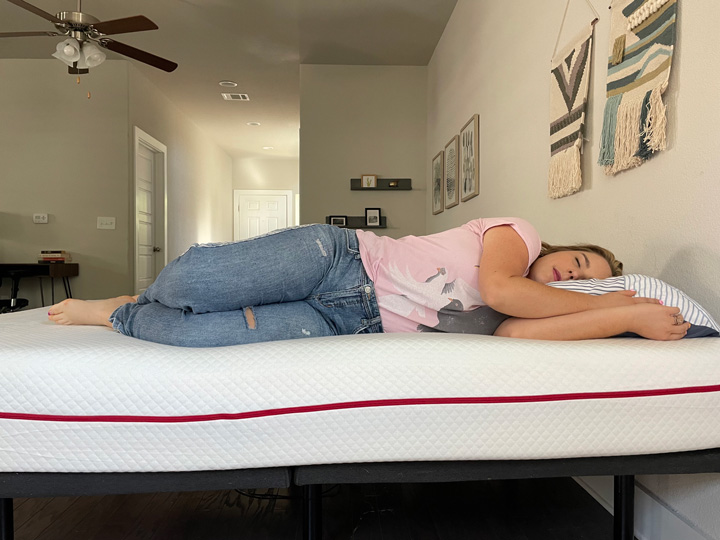Though they’re both made in Canada, the Douglas and Endy mattresses aren’t identical. If you’re trying to decide which one will best meet your sleep needs, our unbiased Douglas vs Endy mattress comparison will answer all of your questions!
Keep reading to learn more about each mattress’s firmness, feel, pricing, and more.
Compare the Douglas and Endy Side-by-Side

|

|
|
| Douglas Mattress | Endy Mattress | |
| Rating | ||
| Firmness | Medium-firm: 6.5/10 | |
| Material | Foam | Foam |
| Cooling | — | — |
| Best For |
Side Sleepers
|
Back Sleepers
|
Douglas vs Endy Video Comparison
Watch as we put these two mattresses head-to-head in our comparison video!

Douglas vs Endy Overview
For this comparison, we’ll focus specifically on the all-foam versions of the Douglas and Endy. Don’t be fooled by their similar constructions! These two mattresses have several notable differences. Here’s a quick overview of who may like each bed:
| Who Should Choose the Douglas Mattress? | Who Should Choose the Endy Mattress? |
| Fans of softer mattresses | Fans of medium-firm mattresses |
| Fans of a slow-moving feel | People who want a balanced foam feel |
| Side sleepers | Back sleepers |
Douglas vs Endy: Similarities and Differences
First things first – let’s see what these two beds have in common and learn more about their differences.
| Similarities | Differences |
| They’re both all-foam mattresses. | The Endy is medium-firm, while Douglas is a bit softer. |
| They have similar customer service terms. | The Endy is better suited for side sleepers, while the Douglas works best for back sleepers. |
| Both mattresses isolate motion well. | There are different materials in the comfort layers. |
| They both have removable and washable covers |
Want to learn more? Read our full Douglas mattress review and Endy mattress review.
Firmness and Feel Differences
The Douglas and Endy mattresses are similar in terms of firmness and feel, but not quite identical. The Douglas mattress feels softer than average, coming in at 6/10 on our firmness scale. The Endy mattress comes in at the industry standard medium-firm, which is 6.5/10.
Sleeping On the Douglas and Endy Mattresses
Most back and side sleepers should feel comfy and supported on these mattresses. However, the Douglas mattress offers more pressure relief for side sleepers and the Endy offers more support for back sleepers. Neither mattress is supportive enough for stomach sleepers, however, so if you rest in this sleeping position we recommend getting one of the best firm mattresses.
What Do The Douglas And Endy Mattresses Feel Like?
The Douglas mattress has more of a slow-moving feel, so sleepers will feel more body contouring and plushness on this mattress in comparison to the Endy.
The Endy mattress feels more balanced. Sleepers won’t sink into the top layers as much, but they’ll still feel some cushioning on their joints.
Average Weight Sleepers – 130 lb – 230 lb
The Douglas and Endy mattresses work well for back and side sleepers, though some side sleepers will prefer the Douglas because it feels slightly softer. On the flip side, back sleepers will likely prefer the Endy mattress because it offers more lumbar support.

We don’t recommend either mattress for stomach sleepers because they aren’t supportive enough to keep the spine in the proper alignment.

RELATED: Best mattresses for stomach sleepers
Heavyweight Sleepers – Over 230 lb
Back sleepers who weigh between 230 and 300 lb should feel supported on the Endy mattress, but we don’t recommend either mattress for anyone else in the heavyweight category. Because the Douglas and Endy mattresses only contain foam, they aren’t as supportive as many hybrid and innerspring mattresses. All in all, heavyweight sleepers will find better options in our list of the best mattresses for heavy people.
Lightweight Sleepers – Under 130 lb
Both mattresses are great matches for lightweight sleepers – no matter the sleeping position! If you fall in this weight category, you should feel supported and comfy on both the Douglas and Endy.
Mattress Construction Differences
To really understand the differences between these two mattresses, we’ll need to look at them layer by layer. Check out our charts below to learn more about each bed’s construction!
Douglas
| Layer | Description |
| Cover | Made with Infinitex™ fibers, the Douglas CoolSense Cover is not only cool and breathable – it’s also machine-washable! |
| Comfort Layer #1 | The first comfort layer contains 2” of Luxury EcoLight® Cooling Gel Foam, which has a slow-moving feel and doesn’t trap heat. |
| Comfort Layer # 2 | Beneath the first comfort layer sits 2” of Premium Elastex® Foam. This material feels more responsive than the EcoLight Gel Foam, and it acts as a transition layer. |
| Support Layer #1 | The Douglas mattress has 6” of Motion Isolation Support Foam at the bottom. This material offers both durability and lumbar support. |
Endy
| Layer | Description |
| Cover | The Endy mattress features a Micro Quilted Cover, which feels stretchy and breathable. It’s also machine-washable. |
| Comfort Layer #1 | The first layer contains Endy’s Comfort Foam, which has an open cell structure for extra breathability and airflow. |
| Comfort Layer # 2 | Next, you’ll find a transition layer which helps eliminate motion transfer. |
| Support Layer #1 | The Endy also has a thick layer of base foam at the bottom, which offers support and gives the mattress a long lifespan. |
Mattress Height
Both mattresses are 10” tall.
Douglas And Endy Performance Differences
Let’s take a closer look at these Canadian mattresses! We put the Douglas and Endy through a number of tests to examine their cooling features, motion transfer, edge support, and more.
Sleeping Hot or Cold
Both mattresses contain impressive cooling features, but Endy’s breathable comfort layer does a better job at promoting airflow. If you’re a particularly hot sleeper, Endy is the best option.
Motion Transfer
Because these mattresses have similar all-foam constructions, they both isolate motion well. It’s tough to give the win to either one – they’re both great mattresses for couples worried about motion transfer.
Edge Support
Edge support is also important to consider. If your bed sinks near the sides, it could force couples to rest closer to the center of the mattress.

Neither mattress has excellent edge support, but you shouldn’t feel like you’ll roll off the sides. However, if this is an important aspect for you, we recommend looking for a hybrid or innerspring mattress.

Durability
Most mattresses last between five and seven years, but because these beds contain some high-quality materials, we expect them both to last a bit longer than average – about seven years.
Off-Gassing
If you’ve ever opened a bed-in-a-box mattress, you probably noticed a slight chemical smell. We call this “off-gassing,” and it’s quite common. Both the Douglas and Endy mattress emitted a faint odor at first, but after the first 48 hours, the smell completely faded away.
Noise
Because both mattresses contain only foam, they don’t make noise when you move around on them.
Sex
Couples looking for one of the best mattresses for sex typically want beds that are easy to move around. Between the two options, we give the win to the Endy mattress. Though not particularly bouncy, this mattress feels more responsive than the Douglas, so couples will have an easier time getting intimate.
Douglas vs Endy Mattress Size Options and Price
Last but not least – pricing! Let’s take a closer look at how much these mattresses cost.
Douglas
| Size | Dimensions | Price |
| Twin | 38″ x 75″ | C$599.00 |
| Twin XL | 38″ x 80″ | C$649.00 |
| Full | 53″ x 75″ | C$699.00 |
| Queen | 60″ x 80″ | C$799.00 |
| King | 76″ x 80″ | C$899.00 |
| California King | 72″ x 84″ | C$899.00 |
Endy
| Size | Dimensions | Price |
| Twin | 39″ x 75″ | C$ |
| Twin XL | 39″ x 80″ | C$745.00 |
| Full | 54″ x 75″ | C$820.00 |
| Queen | 60″ x 80″ | C$895.00 |
| King | 76″ x 80″ | C$995.00 |
| California King | 72″ x 84″ | C$995.00 |
Need more options? Check out more of our mattress comparisons.
Company Policies
We aren’t done yet! It’s also important to examine the company policies before purchasing a new mattress.
Warranty Info
Both mattresses are backed by 15-year warranties.
Sleep Trial
The Douglas mattress has a 365-night sleep trial period, while the Endy’s trial period lasts 100 days.
Return Policy
Not a fan of your new mattress? Don’t stress. As long as it’s within the initial sleep trial period, you can return your mattress and receive a full refund.
Product
Firmness
Score
FAQs
If you still have questions, check out our FAQ section below.
Which mattress is better, Douglas or Endy?
Both mattresses have their merits, so it ultimately boils down to what you want out of a bed. The Douglas feels slightly softer and has a slow-moving feel. The Endy mattress is medium-firm and feels more balanced.
How long will the Douglas and Endy mattresses last?
We expect both beds to last about seven years – which is about average for memory foam mattresses.
Can you flip the Douglas or Endy mattresses?
No, these aren’t flippable mattresses. Both beds have high-density support layers at the bottom, so if you flipped them, they wouldn’t feel comfortable.

